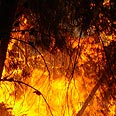
Biriyah forest on fire
Photo:JNF

JNF
Photo: GPO
If you look from afar you will not see right away that something is not right. But when you get closer you get an unpleasant, almost chilling feeling from the sight of entire forests full of tall trees charred to the roots, lacking branches and leaves. Some of them drip resin on the blackened trunk, the natural response of the tree that is trying, in vain, to heal its wounds.
It will take 60 years for the forests - planted in the 1950s by new immigrants who came to Kiryat Shmona and wanted green scenery across from their homes - to return to their previous state. Sixty years. Almost as long as Israel has been in existence.
Jewish National Fund officials, who during the war dealt with 600 fires in northern Israel’s forests, speak of 750,000 trees burned during the war, among them oaks, terebinths, and cypress trees.

Biriyah forest after the fire (Photo: JNF)
The worst damage was in the Naftali mountain range, where some 2,000 acres, or more than 75 percent of the forest, was burned. In the Biriyah and Bet Keshet forests more than 500 acres were burned.
Rehabilitation efforts are expected to cost more than USD 45 million. The money will go toward preparing the ground for more planting, care of trees, purchase of saplings, purchase of fire trucks, and acquisition of hundreds of tons of flame-retardant materials.
The JNF will also be rehabilitating parks and other areas harmed by the fires. In order to undertake this costly project the organization will be launching a campaign in Israel and abroad to raise money and increase awareness of the problem.
Forests will be full of greenery by winter
Zvika Eilon, Director of the Community and Forest Department of the JNF’s northern region, explains that each of the places affected by the fires will be handled differently.
“There are places where we won’t do anything, and we’ll let the trees increase naturally. There are areas where we’ll replant with a different species of vegetation if we decide that it’s more appropriate to today’s climate. We’ll judge each case separately.”
Despite the tremendous damage sustained by the area, JNF officials promise that the forests will be full of greenery by winter.
“We’ll try to make something good out of each thing,” says Eilon. “Eventually the forests will return to what they once were, or they’ll be in even better shape.”















